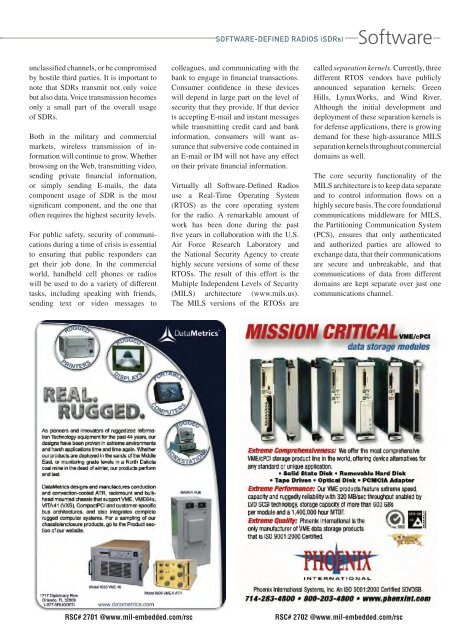Military Embedded Systems Summer 2006
Military Embedded Systems Summer 2006
Military Embedded Systems Summer 2006
You also want an ePaper? Increase the reach of your titles
YUMPU automatically turns print PDFs into web optimized ePapers that Google loves.
Software-Defined Radios (SDRs)<br />
Software<br />
unclassified channels, or be compromised<br />
by hostile third parties. It is important to<br />
note that SDRs transmit not only voice<br />
but also data. Voice transmission becomes<br />
only a small part of the overall usage<br />
of SDRs.<br />
Both in the military and commercial<br />
markets, wireless transmission of information<br />
will continue to grow. Whether<br />
browsing on the Web, transmitting video,<br />
sending private financial information,<br />
or simply sending E-mails, the data<br />
component usage of SDR is the most<br />
significant component, and the one that<br />
often requires the highest security levels.<br />
For public safety, security of communications<br />
during a time of crisis is essential<br />
to ensuring that public responders can<br />
get their job done. In the commercial<br />
world, handheld cell phones or radios<br />
will be used to do a variety of different<br />
tasks, including speaking with friends,<br />
sending text or video messages to<br />
colleagues, and communicating with the<br />
bank to engage in financial transactions.<br />
Consumer confidence in these devices<br />
will depend in large part on the level of<br />
security that they provide. If that device<br />
is accepting E-mail and instant messages<br />
while transmitting credit card and bank<br />
information, consumers will want assurance<br />
that subversive code contained in<br />
an E-mail or IM will not have any effect<br />
on their private financial information.<br />
Virtually all Software-Defined Radios<br />
use a Real-Time Operating System<br />
(RTOS) as the core operating system<br />
for the radio. A remarkable amount of<br />
work has been done during the past<br />
five years in collaboration with the U.S.<br />
Air Force Research Laboratory and<br />
the National Security Agency to create<br />
highly secure versions of some of these<br />
RTOSs. The result of this effort is the<br />
Multiple Independent Levels of Security<br />
(MILS) architecture (www.mils.us).<br />
The MILS versions of the RTOSs are<br />
called separation kernels. Currently, three<br />
different RTOS vendors have publicly<br />
announced separation kernels: Green<br />
Hills, LynuxWorks, and Wind River.<br />
Although the initial development and<br />
deployment of these separation kernels is<br />
for defense applications, there is growing<br />
demand for these high-assurance MILS<br />
separation kernels throughout commercial<br />
domains as well.<br />
The core security functionality of the<br />
MILS architecture is to keep data separate<br />
and to control information flows on a<br />
highly secure basis. The core foundational<br />
communications middleware for MILS,<br />
the Partitioning Communication System<br />
(PCS), ensures that only authenticated<br />
and authorized parties are allowed to<br />
exchange data, that their communications<br />
are secure and unbreakable, and that<br />
communications of data from different<br />
domains are kept separate over just one<br />
communications channel.<br />
RSC# 2701 @www.mil-embedded.com/rsc<br />
RSC# 2702 @www.mil-embedded.com/rsc
















